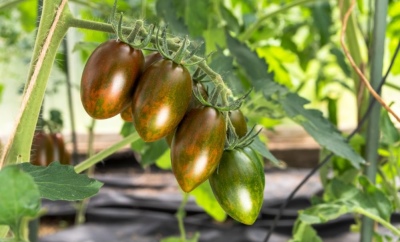
- Category: hybrid
- Growth type: indeterminate
- Appointment: fresh consumption, for whole fruit preservation
- Ripening period: ultra early
- Ripening time, days: 80-85
- Growing conditions: for open ground, for closed ground, for greenhouses
- Bush size: tall
- Bush height, cm: 170-180
- Ripe fruit color: dark brown, no yellow spot
- Fruit shape: cylindrical
Chocolate fingers are a variety of tomatoes that are famous for their excellent taste and original shape, which makes it possible to prepare delicious and aesthetic dishes.
Description of the variety
The bush is of an indeterminate type, tall, reaching a height of 170-180 cm.
The main qualities of the fruit
These are cherry tomatoes, that is, the fruits are very compact, their weight is only 30-35 g. The tomatoes are elongated, cylindrical in shape, and dark brown in color, without a yellow spot.
Taste characteristics
The tomatoes are sweet to taste, the pulp is juicy, dense, and this makes it possible to use the vegetable for whole-fruit canning. Pickled cherry tomatoes are distinguished not only by their excellent taste, but also by their pleasant appearance, which, as a rule, increases the appetite. Of course, fresh tomatoes of this variety will decorate any salad and fill its taste with freshness and pronounced aroma.
Ripening and fruiting
Chocolate fingers are ultra-early ripening varieties. You can remove the first fruits within 80-85 days after germination. Cleaning usually occurs in July - September.
Yield
The variety is considered high-yielding and allows you to get up to 6 kg of fruits from 1 sq. m. Harvesting can be carried out both separately and with whole brushes.
The timing of planting seedlings and planting in the ground
Sowing for seedlings is done in early March, but keep in mind that this is a hybrid variety, which means that your own seeds will not be suitable for sowing, so planting material must be bought every season.
Before sowing, be sure to process the seeds in a solution of potassium permanganate. A mixture of simple soil, peat, sand and humus is suitable as a substrate. The grains are buried 1-1.5 cm, after which the planting site is sprayed with water, and the container under the film is removed to a dark place.
When the first shoots hatch, the film can be removed, and the container can be placed in a place illuminated by the sun. For the entire time, the seedlings need to be fed 2-3 times, and at the stage of 2 leaves, make a pick.
10 days before transplanting to the site, young shoots need to be hardened. To do this, take the cups outside every day, over and over again increasing the time you spend in the fresh air. When the seedlings reach 50-55 days old, they can be transplanted into the garden.

Growing tomato seedlings is an extremely important process, because it largely depends on whether the gardener will be able to harvest at all. All aspects must be taken into account, from seedbed preparation to planting in the ground.
Landing scheme
Plants will feel comfortable if they are planted according to the scheme of 3-4 shoots per 1 sq. m, that is, 50x50 cm. It is allowed to grow tomatoes of the presented variety in open or closed ground, as well as in a greenhouse. The cultivation method depends on the climatic conditions of the region in which the plant is cultivated.

Growing and care
Caring for these tomatoes is classic and includes pinching, garter, shaping, watering, loosening, weeding, feeding. Some points require special attention.
- Top dressing
The plant will develop best if it is fertilized up to six times per season:
when planting in the ground, use organic and mineral compounds;
the next feeding is carried out in two weeks - these are nitrogen, phosphorus, potassium, trace elements;
during the growth period, nitrogen and phosphorus are suitable;
in the flowering phase and in the period of fruit setting, use potassium and phosphorus again, but it is better to refuse nitrogen at these stages;
when fruiting, pay attention to the taste of tomatoes, boron, manganese, iodine have a positive effect on this quality.
- Watering
It is customary to irrigate the ridge as needed, usually once a week, with fruiting - twice a week. Each plant will require 5 liters of water. The best option is drip irrigation. Use settled warm water with a temperature of at least +18 degrees, and water itself early in the morning or in the evening.




A plant needs different micronutrients at each stage of growth. All fertilizers can be divided into two groups: mineral and organic. Folk remedies are often used: iodine, yeast, bird droppings, eggshells.
It is important to observe the rate and period of feeding. This also applies to folk remedies and organic fertilizers.
Disease and pest resistance
The variety has a high immunity against late blight, fruit cracking and fusarium wilting. This is due to the ultra-early ripening period. However, it can be damaged by insects - bear, wireworm, Colorado potato beetle, slugs.



























































































